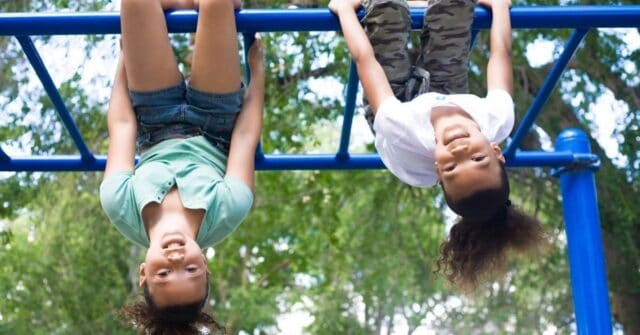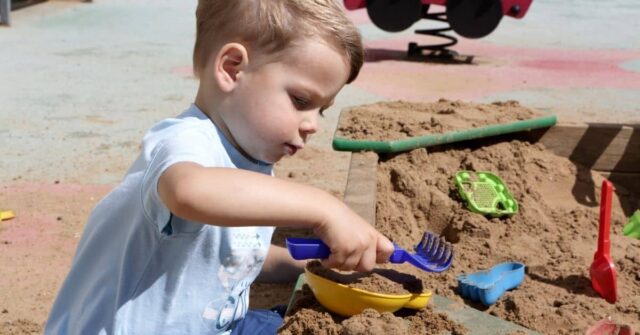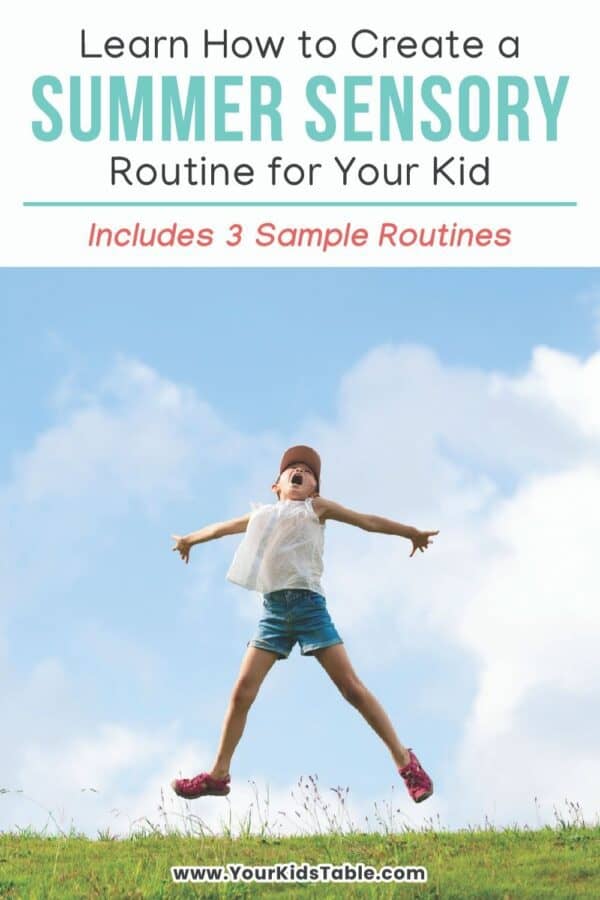Learn how to create a flexible sensory routine this summer for your child with 5 simple steps to help them with their sensory needs so they can play, socialize, follow directions, and have fun!
I love summer. Sipping ice-tea, going on hikes, lazy mornings, and lots of unscheduled time. Unscheduled time might be my favorite part, but all that free time can be a challenge for some kids.
And, while we absolutely want kids to embrace free time and learn how to entertain themselves, it might be a struggle for some kids. For years, parents have told me that while summer is meant to be fun, they dread the lack of structure and routine because their child falls apart.
Plus, parents are managing all sorts of challenging behaviors in large part on their own on those long summer days that never seem to end.
That’s where a simple and flexible summer sensory routine comes into play!
What is a Summer Sensory Routine Exactly?
A summer sensory routine is giving your child regular sensory activities at certain points throughout the day to help them calm, focus, and balance their sensory system (the technical word for this is called regulation).
I believe this can be done simply so that sensory activities are a regular part of your routine. Not something extra that feels like a lot of work. How many sensory activities or strategies you use is totally unique to your child. You might need just 1-2, or your day may include a lot of sensory activities in different ways.
There’s no right or wrong, instead it’s about seeing what’s helpful to your child. And what’s helpful to your child, is helpful to you. If your child is able to play independently, not hit or bite their siblings, or focus for their swimming lessons, then YOUR day is about 1000X easier too!

Who Needs a Summer Sensory Routine?
Do all kids need a summer sensory routine??? Definitely not.
Most kids unknowingly participate in sensory activities that help keep them regulated. They ride their bike, go for a swim, or play in the sandbox regularly. (Did you know those are all sensory activities?)
Because of all that movement and various sensory input, some kids get their sensory needs met.
But, other kids have a lot of sensory needs, and the regular activities aren’t enough. And, some kids can’t, won’t, or just don’t participate in sensory activities. Either way, parents often see the consequences.
In short, kids that would likely benefit from a summer sensory routine are:
- Kids that have sensory sensitivities that make it difficult for them to wear different clothing, touch textures, tolerate movement like swinging or riding a bike
- Kids with a diagnosis of Autism, ADHD, and Sensory Processing Disorder
- Kids that are unmotivated and sit around all the time
- Kids that are so wild and/or aggressive that it affects their ability to follow directions, relax, or socialize with peers.
*Learn 3 Expert Secrets to Calm and Focus Your Kid with Sensory Activities in my free workshop! We’ll send you an awesome free workbook and sensory checklist too!*
How to Create a Summer Sensory Routine
Every child’s summer sensory routine will be unique because it’s based on the challenges and needs they have in their life. Below are 5 steps to help you hone in what will be the most helpful for your child
Step #1: Decide what your goal is
- What’s challenging for your child? Is it aggressive behaviors? Freaking out when it’s time to put on sunscreen? Or, just wanting to lay on the couch and play video games? That will help you choose your goal. Here are some examples of goals you can choose:
- Decrease or stop biting siblings
- Tolerate wearing sunscreen
- Wear different types of clothing
- Participate in play activity outside for a few hours each day
- Be calm enough to sit for meals
- Play well with peers on playdates
- Transition between activities without melting down
- Listen to parent/adult when asked to stop a dangerous activity
- Fall asleep easily in own room.

Step #2: What kind of sensory needs does your child have?
- Sensory activities can be used to help any child as a way of calming and focusing, but kids that have difficulties with their sensory processing have what I like to call sensory needs. In our RISE with Sensory program, students learn to identify which of 4 different types of sensory needs their child has because it’s an important step in knowing which sensory activities will actually help improve those sensory needs.
- These are the 4 types of sensory needs:
- Seeking – loves sensory input and wants more of it all the time. Kids are usually active and described as wild or could touch/smell/lick everything.
- Low registration – seems lazy and just wants to lay around all the time.
- Avoiding – sensitive to textures, sounds, lights, smells, and/or movement.
- Varied – a child can have any combination of the above needs across their 8 senses. (Yes, 8! Besides the ones you learned about in kindergarten, there’s also vestibular, proprioception, and interoception.)
You can also learn more about these types in our free sensory activities workshop!
Step #3: Brainstorm sensory activities that have helped or you suspect might…
- There are all kinds of sensory activities. Some may be helpful in calming and regulating your child. Others may not. A good place to start is considering what activities your child has used before and seemed to help calm or focus them. It could be any of the following:
- Eating something crunchy/salty/sour/sweet/chewy
- Riding a swing/bike/scooterboard
- Playing in a sandbox or getting messy
- Jumping/running/climbing
- Hanging upside down
- Make a list of any and all sensory activities you can think of or click on the links below for some inspiration:
- Take note that kids that fit into the avoiding type of sensory need, may NEVER want to do any sensory activity. But, they need it so they can become desensitized. In this case, you want to list the activities they avoid like riding a swing or playing in the sandbox and put those into your summer sensory routine. If they refuse to participate, you’ll take small steps until they’re comfortable!

Step #4: Incorporate them into your routine
- Take your brainstormed list of sensory activities and circle 5-10 that you want to try first. Now, think about when would be a good time to do them. Can you pull out the yoga ball while your child is waiting for breakfast for them to jump on or sit on while eating? Can they get time on the swing set or take a walk mid morning before their play date?
- This step may take some experimentation. Think through the times of the day in summer that are challenging. You want to try and use the sensory activities BEFORE that happens whenever possible. But, for kids with ongoing sensitivities, plan on daily opportunities to get messy, ride a swing, or whatever it is they’re sensitive to.
Step #5: Reflect on if the sensory activity helped
- A lot of people miss this step when they’re using sensory activities. You have to ask yourself afterwards, if it helped. Again, with kids that avoid and are sensitive, you’ll have to try it many times before you see progress.
- If your child won’t get off the couch and you challenge them to a simple obstacle course before lunch and you notice they’re more talkative and they even want to go swimming when lunch is over, then that’s success. The summer sensory routine is working. But, if they seem more irritable after the sensory activity, then you’ll want to try a different sensory activity.
3 Awesome Examples of Summer Sensory Routines
In this first example, a 5 year old that loves to move, he never stops. He has difficulty listening to his parents or his grandma when she’s babysitting. Sometimes, he’ll even bite his arm or his little sister, although he doesn’t seem angry. Here’s an example of how a summer sensory routine might go for him:
- Hops down the stairs on the way to breakfast
- Sits on a wobble cushion to get some movement while he eats
- Has at least one crunchy food during his meal
- Runs around freely for 20 minutes or jumps on trampoline before heading to a friends house or story time at the library
- Drinks from a spouted water cup that he has to suck hard on to get water out of on the play date
- 30 minutes+ on the scooter board/swimming/swing set/trampoline about 20 minutes after lunch (basically any active play, can last as long as he wants)
- Before bed, he takes a warm bath with lavender essential oil, gets lotion put on, and is snuggled in a rocking chair while reading a book.
The second example is of a 3 year old girl who only wants to wear her underwear or be totally naked because she hates the feeling of clothing. She also can’t stand the swing or roughhousing. She’s usually described as whiny, needy, and anxious. Here’s an example of how a summer sensory schedule might work for her:
- Wakes up to dim lighting, given extra time in bed to wake up
- Mom uses a sensory brush to brush her skin which helps her desensitize 3-4 times a day for 2-3 minutes (Use under guidance of an OT or in RISE program)
- Allowed to stay in underwear until 10 am
- After breakfast, a different sensory bin is put out with long spoons, shovels, and scoops. Mom sits with her at the sensory bin and demonstrates playing.
- After lunch, she pushes a riding toy or tries just sitting on swing with her feet touching the ground
- In the evening, dad runs around with her and does some gentle rough housing in the grass encouraging movement.
The last example is of an 8 year old boy who loves video games and doesn’t even care that it’s summer. He’d rather lay on the couch most of the time. Here’s what his summer sensory schedule might look like:
- After laying around and eating breakfast, he goes for a bike ride with his siblings. Sometimes, he wears headphones with upbeat, fast music
- Mid morning, he takes a movement break and has a choice between bouncing on a yoga ball or jumping on a trampoline as fast as he can for 2 minutes
- Drinks ice cold water with lemon throughout the day
- Goes swimming in afternoon and is encouraged to jump into the water and try different jumping styles to keep him interested. Or the family plans a hike or other movement based activity
- Eats a spicy or sour snack.
Each of these examples show one of the types of sensory needs, except for varied. Remember that type of sensory need includes components of each of the other three so you can mix and match these examples together in that case.
I hope these examples give you an idea of what a summer sensory schedule may look like for your child, but keep in mind that your child may need more or less sensory activity. It also can vary from day to day.
The key is to go into this summer with a rough idea of a routine that evolves as needed over these hot months so that your child (and you) can enjoy it to the fullest!
Learn More About Using Sensory Activities (It’s Free!)
If you want to learn more about how to use sensory activities to calm and focus your kid all the time, then grab a seat in our free workshop, 3 Expert Secrets to Calm and Focus Your Child with Sensory Activities. This is a must-watch if you have a kid with sensory needs.
You’ll get an awesome free workbook that includes a checklist of sensory red flags for you to check too!
More on Summer Sensory Activities
17 Extraordinary Sensory Activities That Help Toddlers Learn and Grow
Ridiculously Do-Able Sensory Integration Activities to Use at Home
Sensory Tricks to Help Your Kid Fall Asleep Fast!
Alisha Grogan is a licensed occupational therapist and founder of Your Kid’s Table. She has over 17 years experience with expertise in sensory processing and feeding development in babies, toddlers, and children. Alisha also has 3 boys of her own at home. Learn more about her here.
